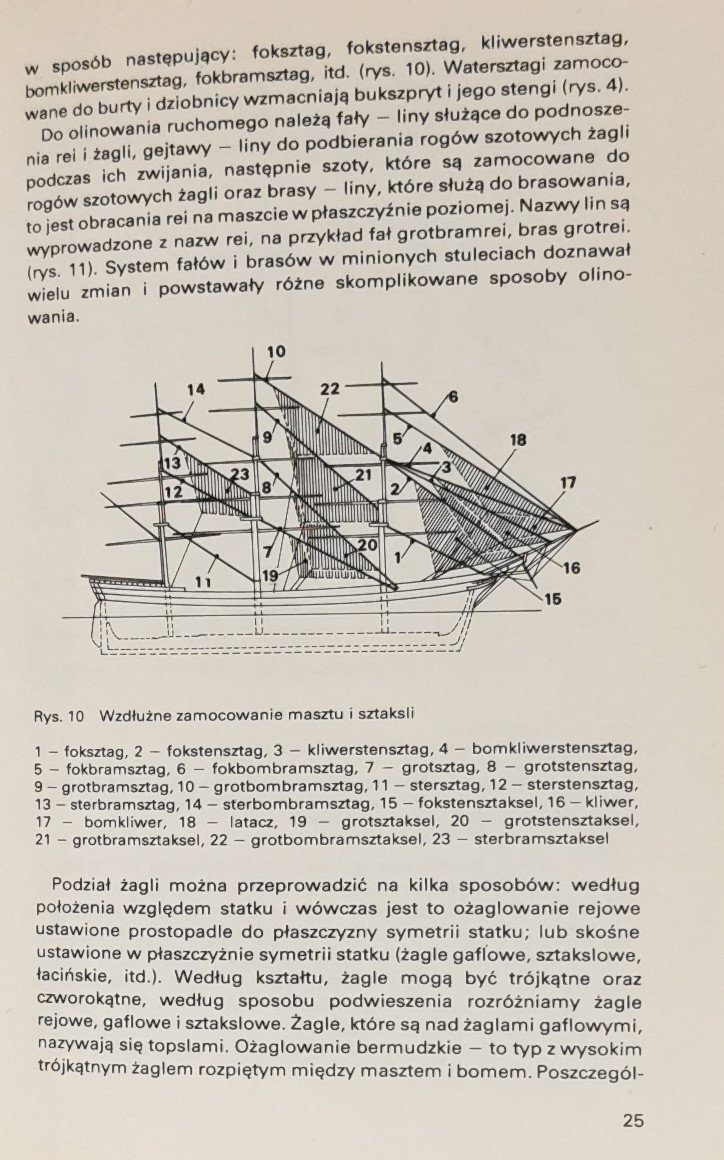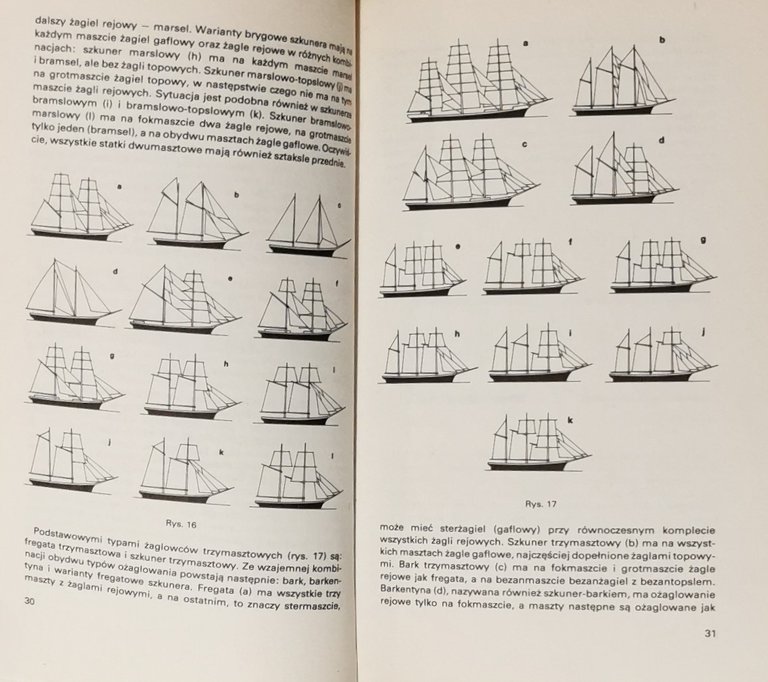
| W czasach dawno i słusznie minionych, zwanych PRL-em, polskie wydawnictwa popularnonaukowe miały tendencję do wydawania przetłumaczonych czechosłowackich atlasów wszelakich. Wydawnictwo „Sport i Turystyka” wydało w ten sposób dwa atlasy ze starymi samochodami, atlasy równie starych motocykli, parowozów i samolotów. A także – żaglowców, którymi zajmiemy się dziś. | In the long and justifiably bygone era known as the People's Republic of Poland, Polish popular science publishers tended to publish translated Czechoslovak atlases of all kinds. The Sport and Tourism Publishing House published two atlases of old cars, atlases of old motorcycles, steam locomotives and aeroplanes. And also - sailing ships, which is what we are going to look at today. |
| Książka wydana w solidnej twardej oprawie to 223 strony naprawdę dość głębokiej wiedzy, która powinna usatysfakcjonować każdego miłośnika pływania pod żaglami. Pierwsze 32 strony to wiedza czysto teoretyczna, bez której jednak pewne fragmenty dalszych opisów mogą się okazać nie do końca zrozumiałe. | The book, published in a sturdy hardback cover, is 223 pages of really quite profound knowledge that should satisfy any sailing enthusiast. The first 32 pages are purely theoretical, but without them some of the later descriptions may not be fully understood. |
| Najpierw więc autorzy przedstawiają nam ogólny zarys historii żeglarstwa, od jego prapoczątków dziesiątki tysięcy lat temu, poprzez epokę rozkwitu, zakończoną upowszechnieniem się parowców w XIX wieku, aż po czasy współczesne autorom, czyli drugą połowę XX wieku. | First, the authors give us a general overview of the history of sailing, from its beginnings tens of thousands of years ago, through its heyday with the spread of steamships in the 19th century, to the authors' present day, i.e. the second half of the 20th century. |
| Zaraz potem następuje najtrudniejsza część całej książki, czyli: jak zbudowany jest żaglowiec. | This is immediately followed by the most difficult part of the book: how to build a sailing ship. |

| Tu przeciętny czytelnik najprawdopodobniej się pogubi w gąszczu żagli, lin i innych elementów, dość szybko zapominając dokładne znaczenia poszczególnych słów.Owszem, zapamięta, że istnieje coś takiego, jak lizel, pikfał czy grotbombramsztaksel, będzie wiedzieć, że należy to kojarzyć z żaglowcem, niemniej co to konkretnie jest – nie ma specjalnie szans zapamiętać. Chyba, że jest uczniem szkoły morskiej, ale nie mówimy tu o ludziach zboczonych zawodowo. | Here the average reader is likely to get lost in the maze of sails, ropes and other elements, and quickly forget the exact meaning of individual words. Yes, he or she will remember that there is such a thing as a studding sail, a peak halyard, or, let's say, a mizzen lower topgallant staysail, and will know that it should be associated with a sailing ship, but he or she will have little chance of remembering what it actually is. Unless he or she is a student at a nautical college, but we are not talking about professional misfits here. |
| Kiedy już z grubsza mamy opanowaną wiedzę o istnieniu tych dziwnych pojęć, przechodzimy do części opisującej różne typy żaglowców. | Once we have a rough idea of the existence of these strange terms, we move on to the section describing the different types of sailing ships. |

| No i tu bez konkretów z poprzedniego rozdziału będzie ciężko zrozumieć i zapamiętać, czym się, na przykład, różni fregata od szkunera i jak się do tej pary ma, powiedzmy, galiota czy inny bryg. | And here, without the specifics of the previous chapter, it will be difficult to understand and remember what the difference is, for example, between a frigate and a schooner, and how, for example, a galiot or another brig relates to them. |
| A jak już przebrniemy przez ten trudny początek, dostaniemy to, co tygryski lubią najbardziej, czyli obrazki. Kolejnych blisko 200 stron zostało podzielone na pary: po prawej – rysunek statku, po lewej opis danego typu i jemu pokrewnych, czasami wręcz konkretnego okrętu – to szczególnie przy czasach bardziej współczesnych. | And once you get through this difficult beginning, you get what Tiggers like best - pictures. The next nearly 200 pages are divided into pairs (on the right - a drawing of a ship, on the left - a description of a particular type and its relatives, sometimes even of a specific ship - this is especially true of more modern times). |

| Więc czekają na nas i starogreckie triery, i malajskie prau, i europejskie karaki z Kolumbową „Santa Marią” jako przykładem, klipry herbaciane, statki wielorybników, ale też wojenne korwety i zupełnie już współczesne żaglowce szkolne z zamykającym książkę „Darem Młodzieży”. | Thus, we are treated to ancient Greek triremes, Malayan proas, European carracks such as Columbus' "Santa Maria", tea clippers, whalers, but also war corvettes and completely contemporary school sailing ships, including the "Dar Młodzieży", which closes the book. |
| Pod względem merytorycznym nie ma czego zarzucić opisom – nie jest to wszak literatura ściśle naukowa, i nawet jeśli byłyby jakieś drobne nieścisłości, nie byłyby w stanie przysłonić wszelkich plusów. Ilustracje również są na wysokim poziomie – wyraźne, szczegółowe, z ładnymi kolorami. Samo tłumaczenie – również jako całość w porządku, choć jednak muszę wrzucić mały kamyczek do ogródka tłumacza, ja też mam swoje zboczenie zawodowe. Strona 200, opis statku „Danmark”, jak sama nazwa wskazuje – duńskiego, i jest napisane, że jego armatorem jest Dyrekcja Wychowania Morskiego w Kodani. Nie wiem, jakim cudem tłumacz przeoczył, że czeska Kodaň to jednak Kopenhaga, ani też jakim cudem umknęło to korekcie. Na szczęście jest to jeden, jedyny rażący błąd tłumaczeniowy, więc i pod tym względem mogę wystawić wysoką ocenę. Całościowo ode mnie 7 punktów dla czytelnika ogólnego i 8,5 dla miłośników żeglarstwa. | In terms of content, there is nothing to complain about in the descriptions - after all, this is not strictly scientific literature, and even if there were some minor inaccuracies, they would not be able to overshadow all the positives. The illustrations are also of a high standard - clear, detailed, with nice colours. The translation itself - again, good overall, with only one glaring translation error (not recognising the Czech/Slovak name of Danish capital city), not influencing the value of the book, so I can also give it a high mark. All in all, 7 points from me for the general reader and 8.5 for the nautical enthusiast. |

Hello avtandil!
It's nice to let you know that your article will take 15th place.
Your post is among 15 Best articles voted 7 days ago by the @hive-lu | King Lucoin Curator by polish.hive
You receive 🎖 0.5 unique LUBEST tokens as a reward. You can support Lu world and your curator, then he and you will receive 10x more of the winning token. There is a buyout offer waiting for him on the stock exchange. All you need to do is reblog Daily Report 157 with your winnings.
Buy Lu on the Hive-Engine exchange | World of Lu created by szejq
STOPor to resume write a wordSTART